by Editor | Feb 27, 2012 | Luxury Travel
Article and photos by Elena del Valle
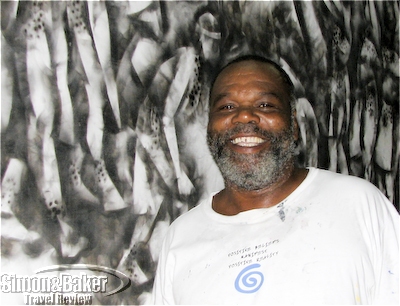
Artist Earl Darius Etienne
Earl Darius Etienne, one of the Dominica’s best known painters, loved art from an early age. For eleven years he created art in the Windward Island before studying at Edna Manley Art School in Jamaica. Today he experiments with unexpected techniques like kerosene torch and banana latex in search of new and distinctive styles. He describes his work style as social realism.
I first saw his work on the street in the town of Massacre on the island’s west coast where he was born in 1957. The large Massacre Mural commissioned in 1988 is considered by some to depict part of Dominica’s history and island life.

The Massacre Mural is on the main road in Massacre (click for larger view)
Later during my stay I had an opportunity to meet the artist for a few minutes thanks to an introduction by Kurnel Simon, his cousin and my guide on the island. Etienne was preparing to exhibit his paintings at an art gallery the following day. He chatted briefly, showed me a couple of his large paintings and discussed his innovative technique of painting with the aid of a flame.

The Kalinago Ritual was painted with fire
His work, originals and limited edition prints, was priced between $100 and $25,000 and was on exhibit at Tiffanys Art Gallery on the Canefield Highway next to the Old Mill Cultural Centre in Canefield and Everybody Gallery on Hillsborough Street in Roseau in Dominica. Online his art could be seen at earletienne.com/ and fineartamerica.com/profiles/earl-darius-etienne.html . For more about Dominica see My week in Dominica.
by Editor | Feb 20, 2012 | Restaurants
Article and photos by Elena del Valle
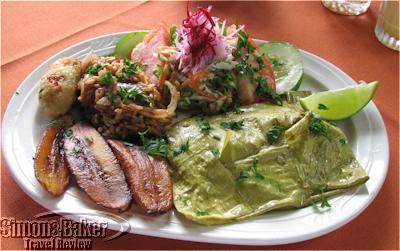
Lunch at Papillote Wilderness Retreat and Tropical Garden
While in Dominica, an ecotourism destination in the Caribbean, I enjoyed mostly organic meals. At the Pavilion Restaurant, the restaurant of the Jungle Bay Resort & Spa where I stayed, the meals were organic. Ingredients at the responsible tourism oriented property were sourced locally. I also liked the opportunity they offered guests to sample Dominican dishes and beverages. At breakfast, there were local tea bags and fresh cocoa tea. One day they made lemongrass tea with fresh plucked lemongrass I brought from a hike. Enjoyment of the healthy food at the poolside restaurant was enhanced by a direct view of the Atlantic Ocean.
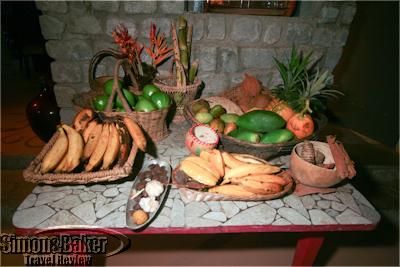
Local fruits
Nearby, at the Riverside Cafe in the Citrus Creek Plantation at La Plaine (Taberi La Plaine + 1 767 446 1234,www.citruscreekplantation.com, riverside@citruscreekplantation.com) I enjoyed the most flavorful and refined meal during my week long visit to the island. The Citrus Creek Plantation, a French owned luxury real estate community under development on the Taberi River near Turtle Beach, was open for lunch (dinner on request). Patricia Charpentier, a native of Normandy, France with life experience in the kitchen, cooked with mostly garden and locally grown and sourced products.
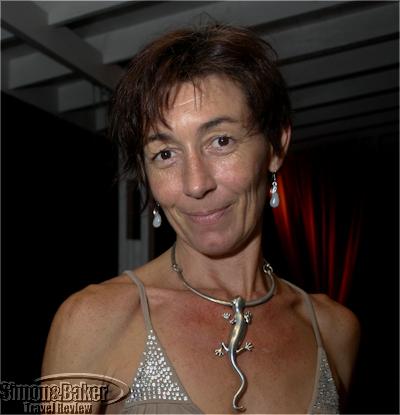
Patricia Charpentier of the Riverside Cafe
While I tasted the green mango, cytere and prune juice (plastic bottled soft drinks were banned) Hervé “RV” Nizard, the owner, described the projects that were being developed on the riverside property. I sampled the Tasting Platter of fried sweet potatoes, boiled plantains, mashed pumpkin, carambola (starfruit), ginger pork, wonderful homemade mustard salad dressing, salted codfish with lime, shredded cabbage, spicy seafood with coconut milk, green papaya and a fresh salad with zeb couresse fragrant creole leaves, and served with French red table wine.
Dessert was chocolate cake made with imported French dark chocolate from neighboring Guadeloupe and served with organic mint, bananas and cinnamon from the garden. It was uber moist and served with banana slices. I fell in love with Charpentier’s carambola and carambola and bitter orange jams. The open air garden side cafe filled with the sounds of the river and insects (not the biting kind) was a most attractive setting to dine and make the meal memorable.

Charpentier’s carambola and carambola and bitter orange jams and chocolate dessert
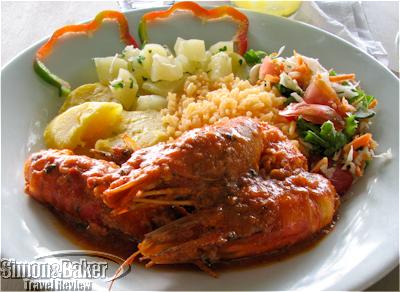
Lunch at Le Flambeau Restaurant
At the beachfront and informal Le Flambeau Restaurant at the Portsmouth Beach Hotel (Picard Plantation, off Robert Ross Blvd, North West Dominica, +767 445-5142, www.leflambeaudominica.com, pbh@cwdom.dm) on the northwest corner of the island I had freshwater crayfish washed down with passion fruit juice followed by coconut and guava ice cream and chocolate cake, both homemade. From my simple plastic chair and table I gazed onto a pretty quiet beach while, occasionally, stray dogs wondered in searching for leftovers.
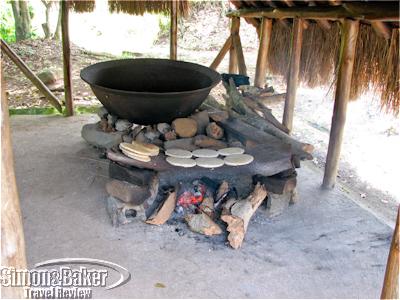
Caribe cooking
In Roseau, I had a delicious local style lunch at the Talipot Gallery within walking distance of my hotel. The art gallery cum restaurant with a view of the Caribbean from the verandah was owned by Nancy Osler. On offer were Dominican and international dishes in the restaurant that catered to locals and visitors. The meals at the Fort Young Hotel, where I stayed, were made fresh daily with local products. The water fronting restaurant offered a lovely setting and views of the Caribbean, the southern end of the island and a partial view of the town. The smoked marlin appetizer on the dinner menu was a favorite of mine.

Anne Jno Baptiste, co-owner, Papillote Wilderness Retreat and Tropical Garden
At the 14-acre Papillote Wilderness Retreat and Tropical Garden (P. O. Box 2287, Trafalgar Falls Road, Roseau, + 767 448 2287, Fax + 767 448 2285 papillote@cwdom.dm ,www.papillote.dm, http://www.papillotegardens.org) in the verdant Roseau River Valley minutes from Roseau yet feeling a world away I had a locally sourced organic meal. During my midday visit I had an opportunity to meet Anne Jno Baptiste, a gracious lady and one of the owners of the property. An enthusiastic staff member guided us around the gardens in the pouring rain (with umbrellas) until my shoes were so wet they made a squishing noise when I walked. In spite of the rainy weather I thoroughly enjoyed my visit and would be pleased to return to explore the gardens in the sunshine, indulge in a hot springs dip and sample other dishes.
by Editor | Feb 13, 2012 | Attractions, Ecotourism, New Articles
Article and photos by Elena del Valle

Dominica is lush and tropical
For most people thoughts of a Caribbean island stay bring forth visions of a vacation spent lazying on powder white sand beaches, gazing at turquoise waters and drinking rum punches served beachside with cute paper umbrellas. One of the reasons I liked Dominica was because it was, for the most part, devoid of such attractions. The highlights of my week long visit to Dominica, a lush green underdeveloped island, without luxury or chain hotels, sandwiched between Martinique and Guadeloupe in the eastern Caribbean, were centered around the island’s natural landscapes and beautiful views.

With the help of Justine, my guide from the Jungle Bay Resort & Spa, I hiked to Victoria Falls
For the active minded there were waterfalls, lakes, hiking paths, and hot springs to discover. As a nature lover I liked the possibility of spotting indigenous fauna and exploring the greenery within hundreds of miles of hiking trails that traversed the island. During my off season visit in addition to hiking, I visited waterfalls, a beach, a gorge, lakes, and rivers. One night after dinner at the pretty Rosalie Bay Resort, I was lucky to see turtle hatchlings crawl from the beach to the Atlantic Ocean.
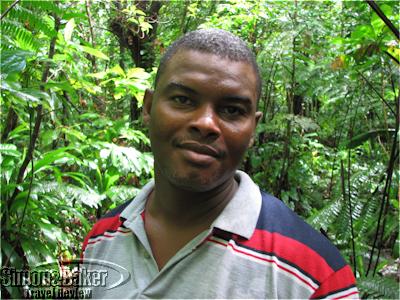
Kurnel Simon, native guide and driver
With the services of Kurnel Simon, a native guide and driver, (Transcendent Tours 3222 Canal Hill, Massacre, + 767 449-3969, kurnicb5@hotmail.com) I saw some of the island’s best known attractions. His patient demeanor, excellent driving skills (driving, on the left along narrow two lane roads, required a sportsman’s attitude in Dominica where many of the roads were under repair or in need of repair) and can do attitude enhanced my experience. Because it was off season the island was pleasantly quiet.
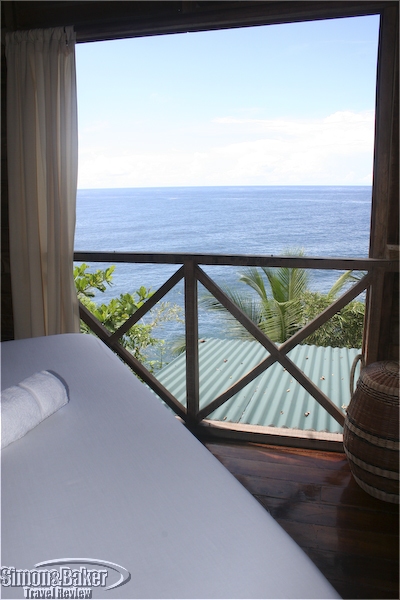
The spa at Jungle Bay looked out on the Atlantic Ocean
In terms of accommodations, I divided my time between the east and west coasts on the southern end of Dominica. First I stayed at the Jungle Bay Resort & Spa at Pointe Mulatre. Although there were many things I enjoyed at the ocean front hill property the one that will stay with me the longest was the sound of the pounding surf from the comfort of my non air conditioned room (the lack of noise from an air conditioner made it possible to hear the sounds of the surf clearly), poolside and at the water facing restaurant.
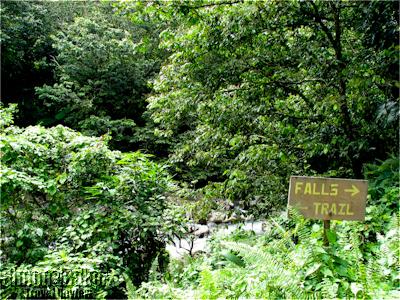
There were many hiking trails in Dominica
Justine, a native of a nearby village, was my guide on a four hour hike to Victoria Falls organized by the Jungle Bay staff. Although the hike tested my resolve more than once and served to showcase Justine’s patience it was a worthwhile way to discover that part of the island. We encountered no souls during the hike and the only sounds we heard were those of nature, the river and the waterfalls.
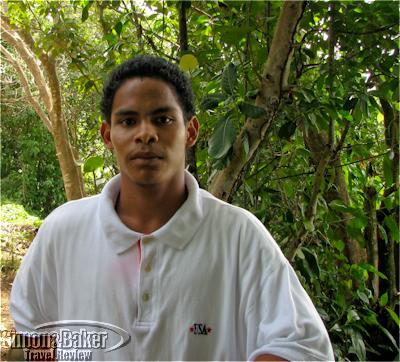
My guide in the Carib Cultural Village by the Sea in Kalinago Barana Aute
To reach the falls, it was necessary to traverse through natural trails, mostly unmarked and often slippery, through pebble and boulder strewn areas, and cross the Victoria Falls River on foot numerous times through strong currents that reached waist high more than once. I fell multiple times although the only major injury was to my pride. Thanks to Justine’s kind nature and our joint perseverance we made it to the edge of the falls (the rocks at the end segment were too steep except for billy goats in human guise and Justine) and back.

The Emerald Pool was a popular swimming and tourist destination
The next day was dedicated to the Emerald Pool and the Carib Cultural Village by the Sea within the Kalinago Barana Aute (Crayfish River, Carib Territory, +767 445-7979, fax +767 445-7533, www.kalinagobaranaaute.com, kbamanager@cwdom.dm) on the eastern coast of the island. Sunday was consumed with tours of the Cabrits National Park and the scenic Indian River followed by a drive through Portsmouth, the second largest town on the island, and a hunger satisfying beachfront lunch at Le Flambeau Restaurant at the Picard Beach Hotel on the northwest corner of the island. I took a moment to walk out on the dock in front of the hotel and made a mental note to return to that part of the island if ever I had a desire for an understated beach with clear water. On our way south to Roseau, the capital where I would stay for the remainder of my visit, we drove along the scenic coastal road.
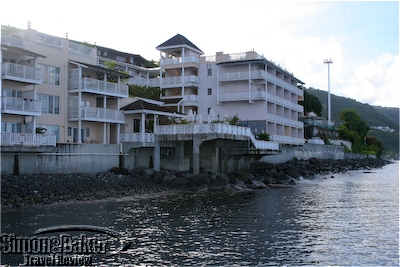
The Fort Young Hotel is on the water
After checking in at the waterfront Fort Young Hotel in the heart of town, I had an early dinner. The following day, I visited the lovely Trafalgar Falls, the Freshwater Lake and Titou Gorge. Mother Nature scheduled nonstop rain all day, helping to keep the island verdant. Because the Lake was enveloped in thick fog and it was chilly we minimized our time there. We carried on with most of the itinerary although we discovered Screw’s Sulfur Spa, the last stop for the day, was closed that week. We attempted to visit another hot spring facility at the last minute with little success.

One of many Waitukubuli National Trail signs
The Waitikubuli National Trail was the island’s claim to fame for hiking. A 3.5 hour hike of Segment 1 of the Trail from Scotts Head to Soufriere was scheduled for the next morning. We were slightly delayed due to some difficulty locating my hiking guide. After collecting him at a nearby village Kurnel Simon dropped us at the beginning of the hiking trail and we set off on the “easy” hike. Although I felt pleased with myself at the end of the hike it confirmed what I suspected following the Victoria Falls hike: that what the Dominicans described as an easy hike would be considered challenging or difficult for me and most of the hiking aficionados, save the most fit and hard core, I know.
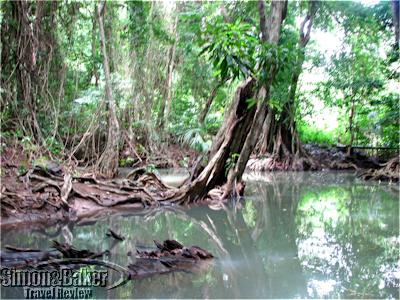
The famed Indian River
Snorkeling the next morning was canceled at the last minute by the snorkeling company. Since we had little time to make alternate plans before the afternoon whale watching excursion we visited the botanical gardens and drove up the hill to enjoy a panoramic view of Roseau.
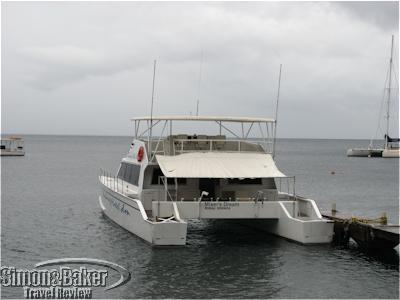
A vessel of the Anchorage Whale Watch & Dive Center
We went whale watching with Anchorage Whale Watch & Dive Center (The Anchorage at Castle Comfort, P.O. Box 34, Roseau, +767 448-2638, fax +767 440-2639, www.experience-dominica.com). After a safety briefing and discussion on whales and dolphins at the hotel where the company operates its tours, 14 of us, 11 passengers and three crew members (Captain Francis Charles, Dave Fabien and Eddie Joseph), went aboard the Miser’s Dream. The 60-foot catamaran motorboat built in 2000 and licensed for a maximum of 50 passengers was comfortable and spacious. Although we struck out on whales (which they see 80 percent of the time, according to the crew) we were delighted to come across spinner and spotted dolphins, a less common find in those waters. After motoring north and south along Dominica’s west coast some three miles from shore and spending 90 minutes under gray and heavily overcast skies we returned.
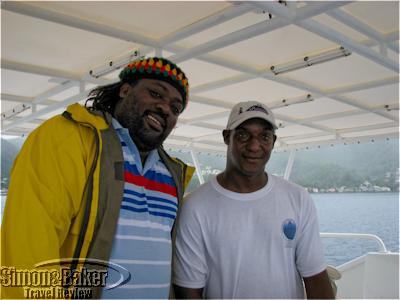
Crew members aboard the Miser’s Dream
Discovering the island’s natural treasures drew me to Dominica for the first time. Its stunning natural scenery, off the beaten track unspoiled character, genuine locals, simple organic meals and the possibility of discovering more of the Nature Island’s hidden beauty including some water attractions like snorkeling, diving and a second try at whale watching would draw me back.
by Editor | Feb 6, 2012 | Accomodations, Attractions, Ecotourism
Article by Laura Scheiber
Photos by Matthew Harris
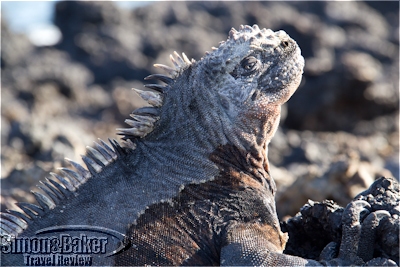
Galapagos marine iguana on the islet of Las Tintoreras
In October, my travel partner and I went to the Galapagos Islands, a UNESCO World Heritage natural site. We found the islands to be a fascinating place because of the unique wildlife. Throughout our trip we saw a myriad of animals that exist nowhere else on the planet, the outcome of adapting to the unique conditions of these isolated islands over millions of years. It was easy to understand why this “natural laboratory” inspired Charles Darwin’s theory of natural selection and evolution.
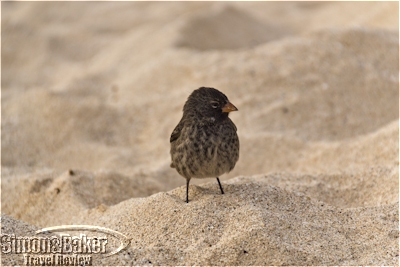
Small ground finch, in Garrapatero Bay on Santa Cruz Island
After traveling to Ecuador, getting to the Galapagos Islands entailed an hour and a half flight from Guayaquil, Ecuador. Our land-based tour lasted six days, hopping between Santa Cruz Island, Floreana Island and Isabela Island. From the moment we landed, we noticed that the islands were teeming with wildlife. We spent our first afternoon on the white sandy beaches of Garrapatero Bay on Santa Cruz Island watching pelicans fish in perfect synchrony, while cheeky finches hopped on our legs, attempting to steal a bite of bread from our lunchtime sandwiches.
Throughout our trip, there was wildlife even in the most mundane places. While waiting for a boat on Floreana Island, for example, we shared the dock with sea lions basking in the sun, pelicans overlooking the sea and a curious iguana that wanted to get a closer look at our camera.

Pelicans fishing in Garrapatero Bay on Santa Cruz Island
Our most memorable encounters were with the famous giant Galapagos tortoises. Weighing up to 500 pounds and measuring 1.5 meters in length, it was amazing to think that some were over 130 years old and had lived during Queen Victoria’s reign, two world wars, the invention of computers and spaceflight. Most of the time these gentle giants were content munching slowly on grass, but we unexpectedly came across two tortoises having a particularly “romantic” moment at the Rancho Primicias tortoise reserve on Santa Cruz Island. I will never, ever, forget those prehistoric sounds.
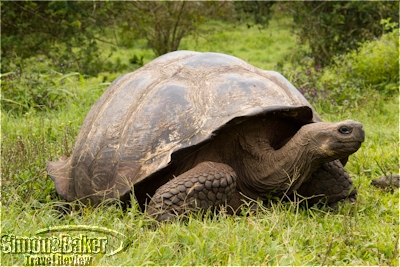
Giant tortoise at Rancho Primicias, Santa Cruz Island
An especially distinctive place that we visited was Las Tintoreras, just off of Isabela Island. Made of lava rock, the islet had a moon-like appearance, made even more surreal by the hundreds of marine iguanas piled on top of one another. These lizards were a good example of evolution in action. In order to survive they have evolved to be semi-aquatic, eating marine algae and staying under water for up to one hour without air.
Las Tintoreras also had a lava-made water channel about three meters wide, where at least twenty white-tip reef sharks rested. Other highlights included snorkeling in crystal clear turquoise water where a sea lion circled my travel partner, and a green sea turtle gracefully swam past me. As we headed back to Isabela Island, we saw some blue-footed boobies, famous to the Galapagos Islands, standing on some rocks.
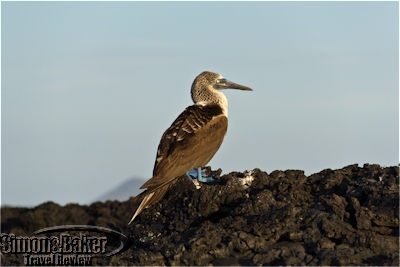
A blue-footed booby near Isabela Island
Because 97 percent of the Islands are part of the Galapagos National Park, visitors must be accompanied by an accredited naturalist tour guide. To be licensed by the Directorate of the Galapagos National Park, these guides had to first pass an intensive course followed by a difficult exam. We booked our land based trip, Darwin’s Triangle Long 3 islands tour, with Red Mangrove Galapagos & Ecuador Lodges (Avenida De Los Shyris 344 y Eloy Alfaro, Edificio Parque Central, Oficina 503, Ecuador, + 593 2 382 3941 or + 888 254 3190 for toll free calls from the United States, http://www.redmangrove.com/, salesteam@redgalapagos.com). Red Mangrove contracted Duncan Divine, who provided interesting and informed context to the fauna and habitats we observed, on our behalf.

Duncan Divine, our excellent naturalist guide
Since we wanted to see as much of the wildlife as possible, we were pleased that the Red Mangrove itinerary was well-organized and packed full from morning to evening. We spent the first and last evenings on Santa Cruz Island, one night on Floreana Island and two nights on Isabela Island. We were busy during the days visiting tortoise reserves, volcanoes, going on hikes, snorkeling (Red Mangrove provided equipment and wetsuits for the 65 degree water) and relaxing on white sand beaches with turquoise water.
We liked the Red Mangrove tour because it was a well-organized land-based trip and offered a socially responsible approach to tourism on a medium-priced budget. The staff were exceptionally friendly and the accommodations were clean and comfortable. All of the lodges on our tour were oceanfront properties and the rooms included shampoo, conditioner, and shower gel from a dispenser, as well as hand soaps, a blow dryer, a glass jar full of drinking water, and security box. Most of the meals were buffet style, and the lunches and dinners included a fish, meat, and vegetarian dish, several salads, a soup, and desserts.
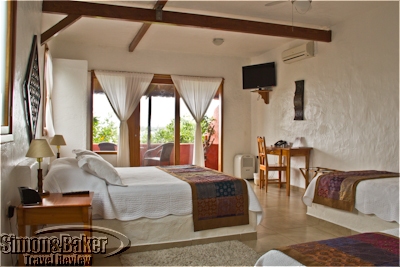
The Jade Room at Aventura Lodge on Santa Cruz Island, Red Mangrove Galapagos & Ecuador Lodges
Overall our trip to the Galapagos Islands was an unforgettable experience thanks to the unique animals that we were able to see at close range. I would recommend a trip to friends and family who love wildlife and the Red Mangrove Galapagos tours for those who prefer a land-based tour with an emphasis on environmentally friendly tourism over luxury.





































